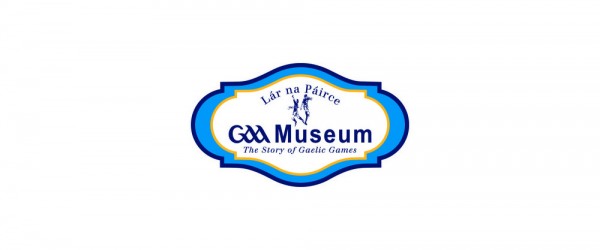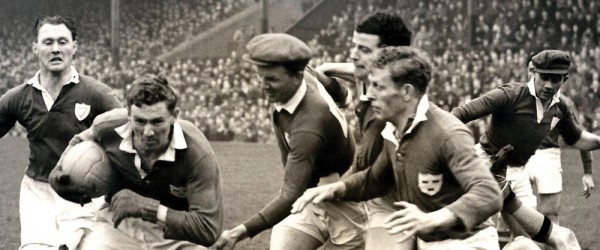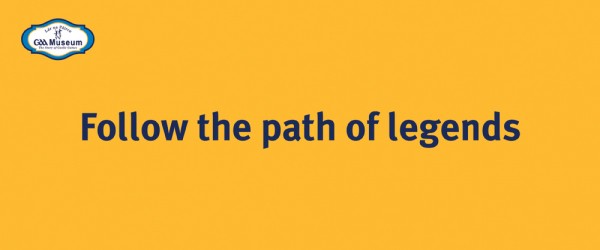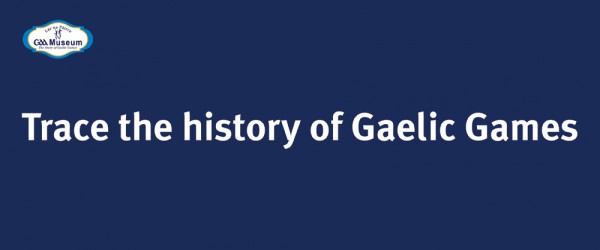One of the most life-like models in the Lár na Páirce exhibition is that of the great broadcaster, Micheal O’Hehir. As he sits before his microphone one almost expects to hear the voice that thrilled thousands of listeners to Irish radio from 1938, until it was stilled by a stroke in 1985. During that period, he broadcast 99 All-Ireland finals and numerous other hurling and football matches, as well as major horse races, show jumping and great national occasions.
When O’Hehir arrived on the broadcasting scene in 1938, he was the immediate solution to the One of the most life-like models in the Lár na Páirce exhibition is that of the great broadcaster, Micheal O’Hehir. As he sits before his microphone one almost expects to hear the voice that thrilled thousands of listeners to Irish radio from 1938, until it was stilled by a stroke in 1985. During that period, he broadcast 99 All-Ireland finals and numerous other hurling and football matches, as well as major horse races, show jumping and great national occasions.
When O’Hehir arrived on the broadcasting scene in 1938, he was the immediate solution to the controversy between the G.A.A. and Radio Eireann. There was a lot of controversy at the time on the competency of the station’s commentators and the manner in which games were broadcast. In fact, the 1937 All-Ireland final, which was played at Killarney, wasn’t broadcast.
Dr. T. J. Kiernan, the Director of Broadcasting in Radio Eireann, decided to advertise publicly for commentators. One of the applicants was a young, brash, bumptious teenager and he was one of five candidates to be tested. They were each given a five-minute trial run at a National Football League game between Louth and Wexford. O’Hehir was the last aspirant and when he had completed his five minutes, he was asked to do all of the second half of the game. The rest is history as the 17-year old was to broadcast for the nest 47 years.
Micheal O’Hehir’s first real broadcast was of the All-Ireland senior football semi-final between Galway and Monaghan at Mullingar on August 14, 1938, He takes up the story: ‘I was given £3 – 10 – 0 for the broadcast. The train fare to Mullingar was 7/6. I was as nervous as a kitten but my father, who sat outside the broadcasting box, was worse. He had a Rosary beads in his hands, praying for me. Once the game began I just kept describing the action. After the game, we returned home. I was convinced that I had done a bad job of the broadcast. I was in a terrible state. But on arriving in Drumcondra and near to our house we met a great friend of the family, Tommy O’Reilly. He was an honest man who gave his opinions bluntly and straight forward. He assured me that I had done a great job. I was delighted and relaxed for the first time in days. And, I have not shut up since . . .’
Micheal O’Hehir became the voice of the G.A.A. for the next 47 years. Sunday after Sunday he was at some venue in one of the 32 counties relaying the excitement of a hurling or football game to his listeners. In the era of ‘wet’ and ‘dry’ batteries he was king of the airwaves. Communal listening was commonplace then. Excited fans gathered round the radio on a street in a small town or outside the window of an isolated house in rural Ireland. His words and descriptions were gospel. His exciting commentary had men throwing their hats in the air and dancing Irish jigs with their exposed bald heads. Young children ran riot demonstrating the skills O’Hehir described; they were the future Frank Stockwells, Mick O’Connells, Sean Purcells, Christy Rings or Jimmy Smiths.
Another thing these broadcasts did was to make small parishes and isolated townslands known the length and breadth of the country. O’Hehir was great at mentioning the names of players’ clubs and their mention made his listeners preen with pride when their places were given national recognition.
Only a few of the great moments during O’Hehir’s broadcasting life can be mentioned. His commentary of the mass pile-up and chaos at the 23rd fence of the 1967 Aintree Grand National, when he picked out the unheralded Foinavon emerging from the mayhem, is legendary. His four and a half-hour broadcasting marathon from the NBC studios in New York in 1963 as he described the scenes and pictures from President Kennedy’s funeral. So much of his broadcasting had to do with Gaelic games that when the Sunday Tribune in January 2009 carried a list of the 125 most influential people in G.A.A. history, Micheal O’Hehir occupied second place after Michael Cusack.
The paper’s citation on the occasion was aptly chosen: ‘O’Hehir, the voice of the G.A.A., was not so much a commentator as a phenomenon, spreading and popularising the games to an unprecedented degree by creating spells with his words and magically transporting his listeners from their sitting rooms to Croke Park and Semple Stadium.’
Micheal O’Hehir never got to broadcast his 100th All-Ireland. He lived until 1996, passing away on November 24 in that year.
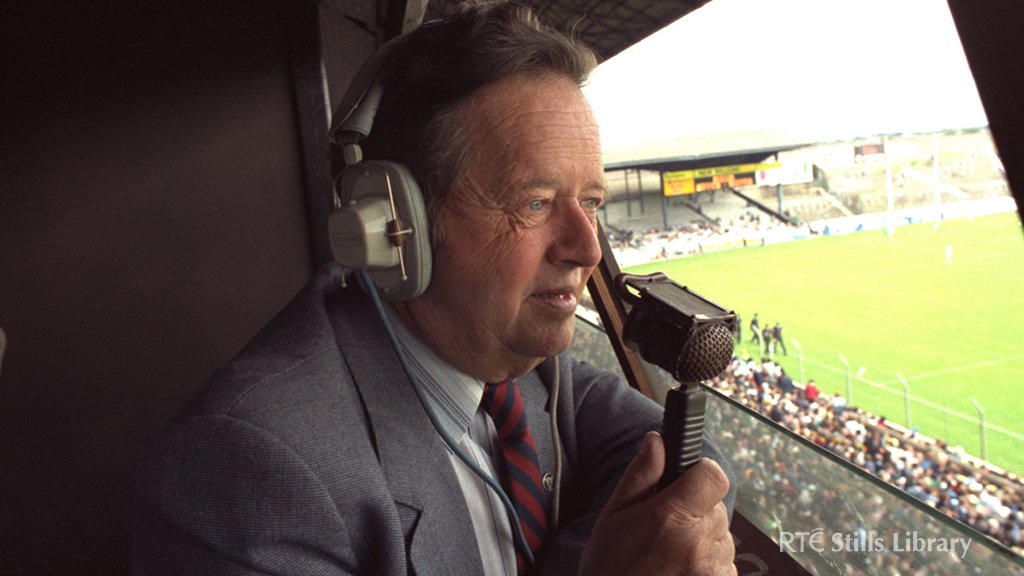 controversy between the G.A.A. and Radio Eireann. There was a lot of controversy at the time on the competency of the station’s commentators and the manner in which games were broadcast. In fact, the 1937 All-Ireland final, which was played at Killarney, wasn’t broadcast.
controversy between the G.A.A. and Radio Eireann. There was a lot of controversy at the time on the competency of the station’s commentators and the manner in which games were broadcast. In fact, the 1937 All-Ireland final, which was played at Killarney, wasn’t broadcast.
Dr. T. J. Kiernan, the Director of Broadcasting in Radio Eireann, decided to advertise publicly for commentators. One of the applicants was a young, brash, bumptious teenager and he was one of five candidates to be tested. They were each given a five-minute trial run at a National Football League game between Louth and Wexford. O’Hehir was the last aspirant and when he had completed his five minutes, he was asked to do all of the second half of the game. The rest is history as the 17-year old was to broadcast for the nest 47 years.
Micheal O’Hehir’s first real broadcast was of the All-Ireland senior football semi-final between Galway and Monaghan at Mullingar on August 14, 1938, He takes up the story: ‘I was given £3 – 10 – 0 for the broadcast. The train fare to Mullingar was 7/6. I was as nervous as a kitten but my father, who sat outside the broadcasting box, was worse. He had a Rosary beads in his hands, praying for me. Once the game began I just kept describing the action. After the game, we returned home. I was convinced that I had done a bad job of the broadcast. I was in a terrible state. But on arriving in Drumcondra and near to our house we met a great friend of the family, Tommy O’Reilly. He was an honest man who gave his opinions bluntly and straight forward. He assured me that I had done a great job. I was delighted and relaxed for the first time in days. And, I have not shut up since . . .’
Micheal O’Hehir became the voice of the G.A.A. for the next 47 years. Sunday after Sunday he was at some venue in one of the 32 counties relaying the excitement of a hurling or football game to his listeners. In the era of ‘wet’ and ‘dry’ batteries he was king of the airwaves. Communal listening was commonplace then. Excited fans gathered round the radio on a street in a small town or outside the window of an isolated house in rural Ireland. His words and descriptions were gospel. His exciting commentary had men throwing their hats in the air and dancing Irish jigs with their exposed bald heads. Young children ran riot demonstrating the skills O’Hehir described; they were the future Frank Stockwells, Mick O’Connells, Sean Purcells, Christy Rings or Jimmy Smiths.
Another thing these broadcasts did was to make small parishes and isolated townslands known the length and breadth of the country. O’Hehir was great at mentioning the names of players’ clubs and their mention made his listeners preen with pride when their places were given national recognition.
Only a few of the great moments during O’Hehir’s broadcasting life can be mentioned. His commentary of the mass pile-up and chaos at the 23rd fence of the 1967 Aintree Grand National, when he picked out the unheralded Foinavon emerging from the mayhem, is legendary. His four and a half-hour broadcasting marathon from the NBC studios in New York in 1963 as he described the scenes and pictures from President Kennedy’s funeral. So much of his broadcasting had to do with Gaelic games that when the Sunday Tribune in January 2009 carried a list of the 125 most influential people in G.A.A. history, Micheal O’Hehir occupied second place after Michael Cusack.
The paper’s citation on the occasion was aptly chosen: ‘O’Hehir, the voice of the G.A.A., was not so much a commentator as a phenomenon, spreading and popularising the games to an unprecedented degree by creating spells with his words and magically transporting his listeners from their sitting rooms to Croke Park and Semple Stadium.’
Micheal O’Hehir never got to broadcast his 100th All-Ireland. He lived until 1996, passing away on November 24 in that year.
Lár na Páirce
Museum of the GAA and Gaelic Games
